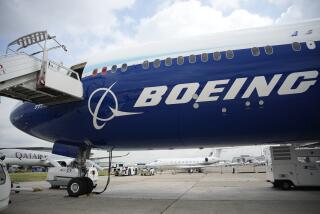Boeing Betting 777 Will Be Its Lucky Number : Aviation: Aerospace leader unveils the airliner today. The firm says the plane will change the way it does business.
- Share via
EVERETT, Wash. — They designed it entirely on a computer. It’s powered by two engines instead of four, which will require rigorous testing for long-haul trips. Hundreds of the planes may have to be sold just to break even.
But Boeing Co. engineers have placed a multibillion-dollar bet that the aerospace leader’s newest wide-body jet, the 777, will succeed. The unveiling of the first 777 today, orchestrated with an invitation-only shindig at a Boeing factory complex, will give customers, suppliers and many workers their first intimate view of the plane that will take Boeing into the 21st Century.
One hundred thousand guests are expected for the rollout of this high-tech debutante, which is slightly smaller than Boeing’s jumbo 747-400. Its advances range from electronic cockpits to user-friendly lavatory seats that don’t bounce around in turbulence.
The 777 introduction comes at an awkward time. Commercial airlines have been reeling from years of punishing losses. Boeing itself has slashed production and cut thousands of jobs.
Nonetheless, Boeing’s long-term strategists estimate the world’s airlines will need 12,000 new planes worth $815 billion by 2010, with jets like the 777 accounting for nearly 40% of sales.
Boeing says the 777 has fundamentally changed the way it does business, how it designs and builds aircraft, and its relationships with airlines, suppliers and employees. Customers such as British Airways and United Airlines say they’re so pleased with the openness Boeing has shown they now demand similar treatment from competitors.
“It’s been a revolution from one end to the other,” said Paul Nisbet, an aerospace industry analyst with JSA Research in Newport, R.I.
Sixteen customers have ordered 147 777s and signed options to buy another 108. Each costs $116 million to $146 million, depending on interior configuration.
Boeing won’t say how much the plane cost to design and build, but outside experts estimate a cost of at least $4 billion. Boeing constructed new factories and labs to produce the plane. It collaborated with leading businesses in Japan, America’s high-tech rival, to share the risks of development.
One of the biggest risks is whether government regulators will permit the twin-engine plane to fly long over-ocean routes. Previously, twin-engine planes have had to prove reliability for at least two years in service before such permission has been granted.
Boeing is gambling that it will have such approval when United puts the first 777 in service by May, 1995. Ron Robinson, 777 chief engineer for test integration, said nine airplanes will make a total of 4,820 test flights. The maiden flight is this June.
Twin-engine power is one of the plane’s most alluring qualities for buyers. It is expected to be far more efficient than four-engine models and less costly to maintain.
The plane is the first Boeing designed entirely on computer. Except for a few critical areas, such as the cockpit and passenger doors, there was no mock-up--the model historically used to make sure parts fit together.
“The bottom line is, everything came together right where the engineers said it’s supposed to and everything fit,” said Edward Chapin, supervisor for the forward body and wing section at the Everett factory.
Maybe so, but the profit is still in question. Nisbet said Boeing might have to deliver 300 planes before it breaks even.
The first 777s will carry 375 passengers 4,240 miles. A longer-range “B” market version, available in December, 1996, will carry 305 passengers up to 8,490 miles--50 miles farther than the 747-400.
The engines, made by Pratt & Whitney, General Electric and Rolls Royce, are the largest ever built--the GE cowling (the exterior of the engine) is wider than a 757 jetliner cabin.
The 777 also is Boeing’s first “fly-by-wire” aircraft, meaning that electronic circuits, not mechanical links, carry commands to the rudder and ailerons.
Boeing began studying a new airplane in 1986 to fill the gap between its 218-passenger 767-300 and its 420-passenger 747-400. The plane also was an attempt to catch up with Airbus Industries’ A330-A340 aircraft and McDonnell Douglas’ MD-11, 300-passenger planes already in development.
More to Read
Inside the business of entertainment
The Wide Shot brings you news, analysis and insights on everything from streaming wars to production — and what it all means for the future.
You may occasionally receive promotional content from the Los Angeles Times.







